MarTech, conversational UI, and the future of connecting with customers
Contributor Jeff Eckman recaps a session by MarTech San Francisco 2017 speaker Nick Pandolfi of Google’s Global Product Partnerships team in which he shares Google’s view on this emerging topic, as well as five tips on designing for the conversational interface.

Of the growing set of new themes in the exceptional content at this year’s MarTech San Francisco conference, one stood out in particular: conversational interfaces.
Conversational interfaces, or virtual assistants, are growing in popularity and use by marketers. Nick Pandolfi of Google’s Product Partnerships team closed out the Experience Track at MarTech SF 2017 with a 20-minute TED-style talk on the “next new wave” of interfaces: conversational agents.
Here is my digest of Pandolfi’s enlightening presentation, which includes Google’s view on this emerging topic, as well as five tips on designing for the conversational interface.
The next interaction paradigm
In the continuing evolution of the digital frames we interact with, the next new wave of computing, Pandolfi suggested, is conversational agents. Beginning with websites created by publishers, we’ve seen developers make the progression from the browser to touch apps on mobile devices. Conversational agents — in essence, services — enabled by virtual assistants are the next means of interaction with computers.
Websites > Touch Apps > Conversational Agents
What is different about conversational agents is less about the technology itself, more about the new nature of the design. Whereas the design principles used for websites and touch apps are about purposeful guiding of the user, conversational agents are about engaging in a dialogue, and thus, Pandolfi explains, “the design requirements are totally different.”
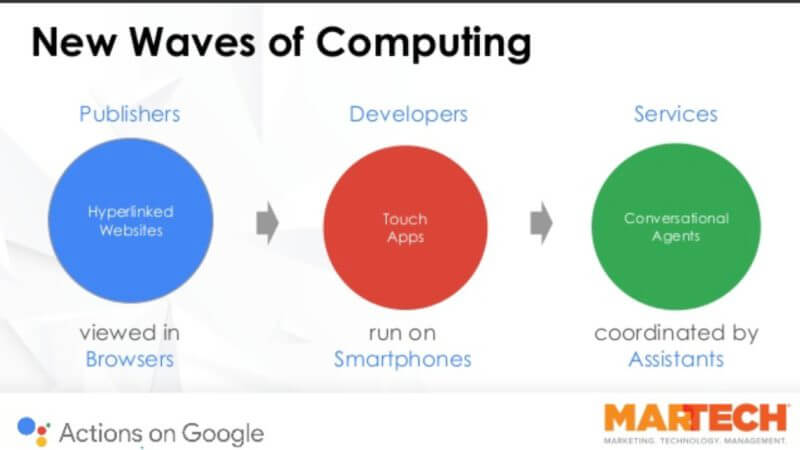
Background on conversational user interfaces (CUIs)
We are all now familiar with voice recognition and its growing accuracy, efficacy and utility. Apple’s Siri, Amazon’s Alexa and the Google Assistant are CUIs that are becoming ubiquitous. This now taken-for-granted technology has been rapidly enabled and enhanced by machine learning and artificial intelligence (AI) for speech recognition and improved text-to-voice quality.
In addition to the smartphone, tablet, desktop/laptop and in-home devices, CUIs are now appearing in watches and in cars. To support growth and proliferation across multiple media, companies including Google are providing SDKs (software development kits) for engineers to develop virtual assistants for deployment on multiple devices. The idea is to build an experience once and publish on multiple platforms.
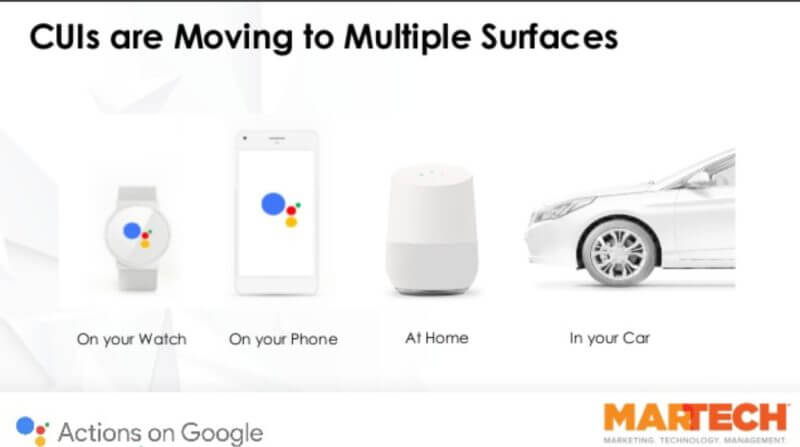
Making the CUI
The tools to build and deploy CUIs already exist within a growing ecosystem. Actions on Google is the company’s platform for developers to use to build CUIs for the Google Assistant. Pandolfi talked about API.AI as a core tool for CUI creation, and specifically noted that there is growing support for creating CUIs within graphic UI-based tools like API.AI and Gupshup — i.e., no code required. Again, Pandolfi reiterated, the hard part is in the design, not the development. Accordingly, he provided some of his suggestions for getting started with CUIs from a design perspective.
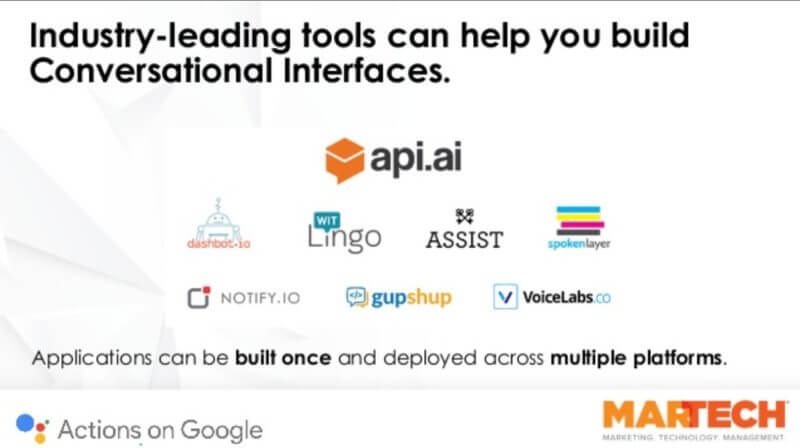
5 tips for conversational UI design
- Start small. Rather than attempting to take your entire set of customer touch points into CUI-land, start with something small — perhaps one component, and/or something with a short length of engagement. Pandolfi cited Progressive Insurance as an example of a firm that’s deployed CUI in a tight, specific manner.
- Create a persona based on brand. Create a style guide, and use recorded audio, or the voice of an actor who may be the face of your brand. One example Pandolfi provided included an iHeartRadio execution used in conjunction with the iHeartRadio Music Awards.
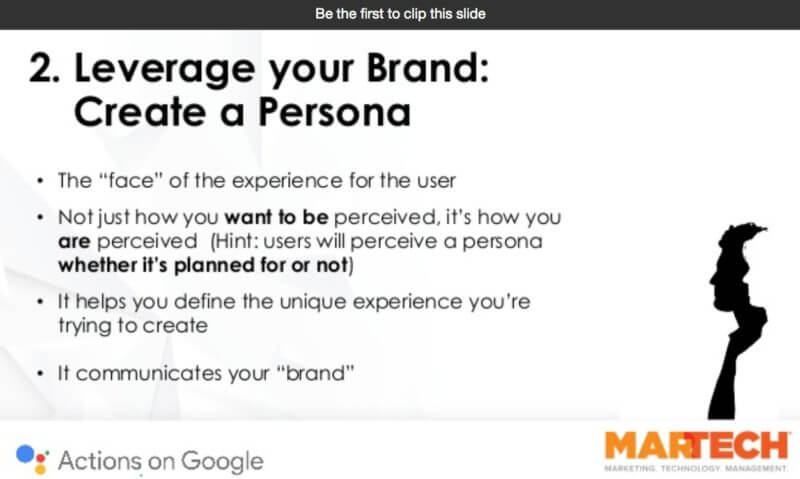
- Dialog design. “Think like a screenwriter,” Pandolfi suggested. Start with use cases, then diagram dialogues. Keep in mind that the welcome message sets the tone and helps guide the user, setting expectations upfront. Then think about and design how the dialogue branches. Once the dialogue design is complete, then use the technology, i.e., execute the development.
- Context matters. Thinking about the customer’s where, what and when is key in design. For example, is the user on the phone or on the go, calling for a shorter dialogue? Or are they at home, where a longer dialogue may make sense? Where is the customer in a process flow? Using the contexts of environmental, situational, temporal and mental/behavioral, design and adjust your conversational actions based on context.
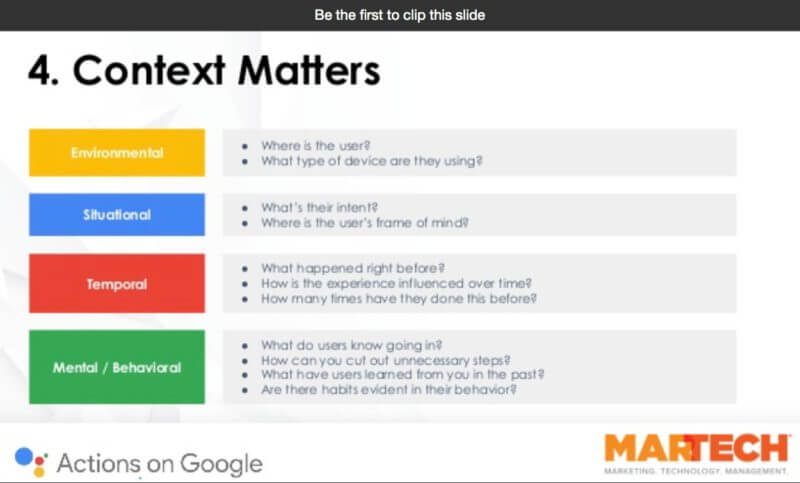
- Error handling. “In Conversations, there are no ‘errors.’” Pandolfi suggested taking care not to insult the intelligence of the user. People understand how to talk, so be natural. Let them know what their options are. And know that users want to be on the right path. Pandolfi provided some helpful guidance on how to think about potential dead-ends and their mitigation.
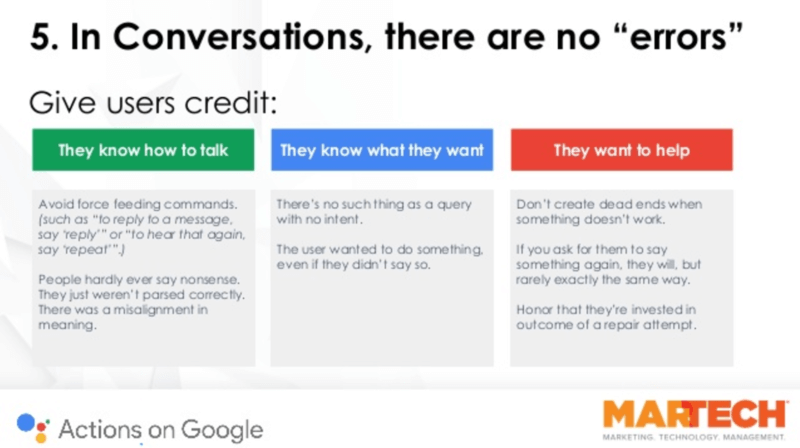
Pandolfi’s session concluded with a brief audience Q&A and some post-session discussion. In 20 short minutes, the talk offered the audience an opportunity to learn about conversational interfaces, both introductory and in-depth, and served as a practical guide for getting started or enhancing an existing CUI program.
Some opinions expressed in this article may be those of a guest author and not necessarily Marketing Land. Staff authors are listed here.
Marketing Land – Internet Marketing News, Strategies & Tips
(45)













